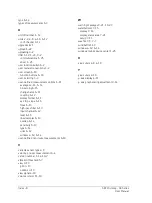
Glossary of Terms
Acceleration
- The time rate of change of
velocity. Acceleration measurements are
usually made with accelerometers.
Accelerometer
- A sensor whose output is
directly proportional to acceleration.
Alarm Setpoint
- Any value beyond which is
considered unacceptable or dangerous to
machinery operation.
Alignment
- A condition whereby the axes of
machine components are either coincident,
parallel, or perpendicular, according to design
requirements.
Amplitude
- The magnitude of dynamic motion
or vibration. Expressed in terms of
peak-to-peak, zero-to-peak, or RMS.
Asynchronous
- Vibration components that are
not related to rotating speed.
Averaging
- In a dynamic signal analyzer,
digitally averaging several measurements to
improve statistical accuracy or to reduce the
level of random asynchronous components.
Axial
- In the same direction as the shaft
centerline.
Axial Vibration
- Vibration which is in line with
a shaft centerline.
Axis
- The reference plane used in plotting
routines. The X-axis is the frequency plane.
The Y
-axis is the amplitude plane.
Balancing
- A procedure for adjusting the radial
mass distribution of a rotor so that the
centerline of the mass approaches the
geometric centerline of the rotor.
Band-Pass Filter
- A filter with a single
transmission band extending from lower to
upper cutoff frequencies. The width of the band
is determined by the separation of frequencies
at which amplitude is attenuated by 3 dB
(0.707).
Bandwidth
- The spacing between frequencies
at which a band-pass filter attenuates the signal
by 3 dB.
Baseline Spectrum
- A vibration spectrum
taken when a machine is in good operating
condition; used as a reference for monitoring
and analysis.
Baud Rate
- Adjustable serial communication
transfer rate. Measured in bits per second.
Bit
- Smallest unit of computer information
storage. Equivalent to a choice of a one or a
zero.
Byte
- A unit of computer information storage
usually equal to eight bits or one character.
Center Frequency
- For a bandpass filter, the
center of the transmission band.
Centerline Position
- The average location,
relative to the radial bearing centerline, of the
shaft dynamic motion.
Channel
- A sensor and the instrumentation
hardware and related software required to
display its output signal.
Condition Monitoring
- Determining the
condition of a machine by interpretation of
measurements taken either periodically or
continuously while the machine is running.
CPM
- Cycles per minute.
CPS
- Cycles per second. Also referred to as
Hertz (Hz).
Critical Speeds
- In general, any rotating speed
which is associated with high vibration
amplitude. Often the rotor speeds which
correspond to natural frequencies of the
system.
Cycle
-
One complete sequence of values of a
periodic quantity.
Displacement
- The change in distance or
position of an object relative to a reference.
Download
- Transferring information to the
measurement device from the host computer.
Enable
- To activate.
Engineering Units
- Physical units in which a
measurement is expressed, such as in/sec,
micrometers, or mils. Selected by the user.
EU
-
See ENGINEERING UNITS.
External Sampling
- In a DSA refers to control
of data sampling by a multiplied tachometer
signal. Provides a stationary display of vibration
with changing speed.
Fast Fourier
Transform
- A calculation method
of converting a time waveform to a frequency
display that shows the relationship of discrete
frequencies and their amplitudes.
FFT
- See Fast Fourier Transform.
Field
-
One data item. Examples of fields are
POINT Type, Description, etc.
SKF Microlog - GX Series
Glossary - 1
User Manual












































